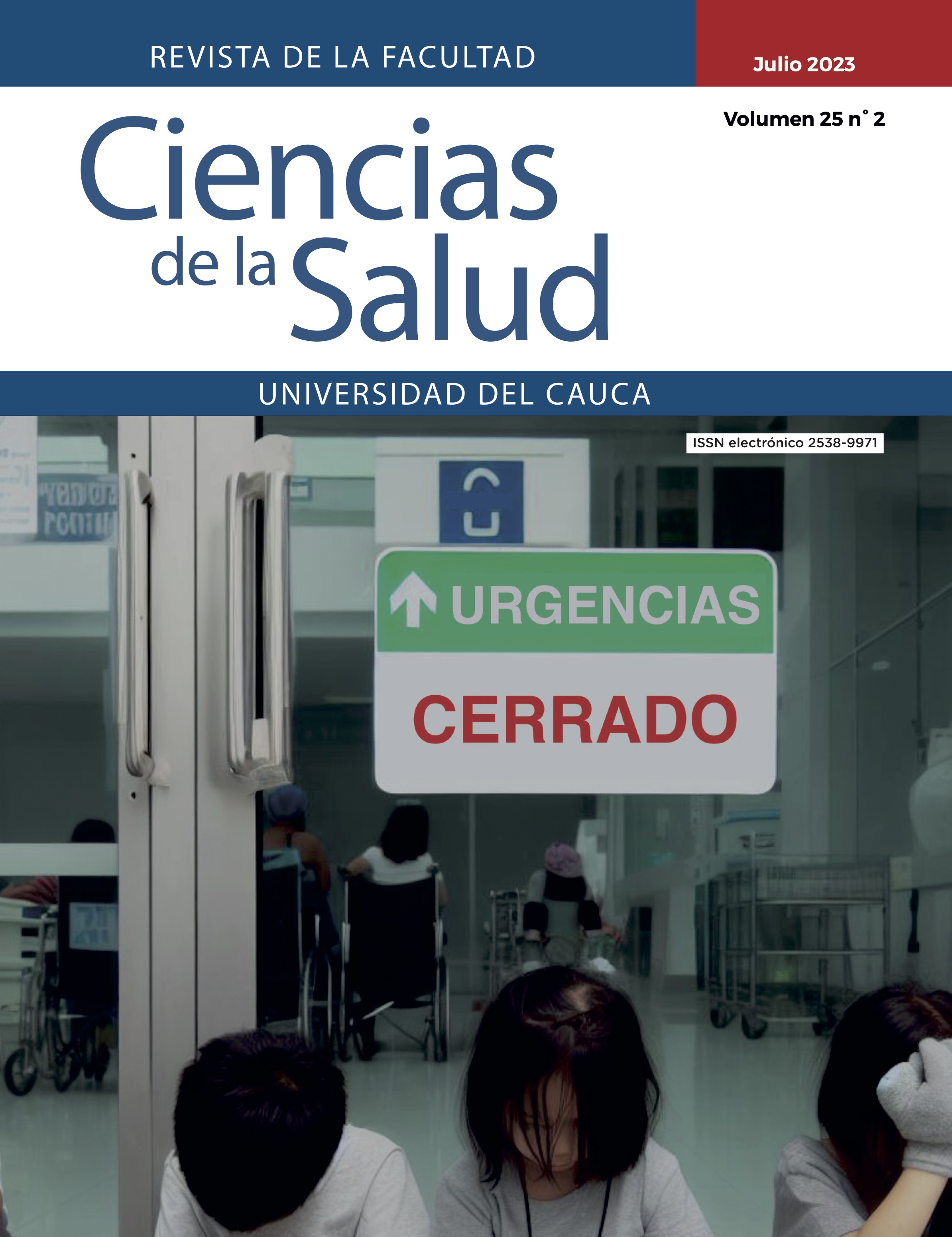Factores de riesgo para alteraciones posturales en niños y adolescentes y el rol del fisioterapeuta en su manejo. Revisión narrativa
Resumen
La escoliosis, hipercifosis cervical e hiperlordosis lumbar son desórdenes musculoesqueléticos de la columna vertebral que con frecuencia inician en la niñez y la adolescencia. Estudios mostraron alta incidencia de alteraciones posturales en estas etapas del curso de vida, con causas multifactoriales y que llegan a afectar la salud aún en la adultez. En Colombia hay poca información sobre los factores de riesgo posturales y el papel del fisioterapeuta en esta población, que sumado a las características del entorno escolar y nacional pueden profundizar la problemática, por lo que se pone en evidencia la necesidad de implementar programas que disminuyan la incidencia de estas alteraciones posturales partiendo desde su conocimiento.
El propósito del presente manuscrito fue revisar las evidencias actuales sobre factores de riesgo y la importancia de la intervención del fisioterapeuta en niños y adolescentes en relación con la postura. Los principales factores de riesgo intrínsecos fueron la edad, sexo, raza y genética, y los extrínsecos el peso excesivo de la mochila, el inadecuado uso del mobiliario escolar y tiempos prolongados en determinadas posiciones. Se ha concluido, además, que el fisioterapeuta en su desempeño con población infantil y adolescente cumple un destacado rol en la prevención y diagnóstico de alteraciones posturales, evitando complicaciones tempranas e impactando positivamente en la salud de esta población.
Descargas
Disciplinas:
Ciencias de la salud, Fisioterapia, PediatríaReferencias bibliográficas
Azevedo N, Ribeiro JC, Machado L. Balance and Posture in Children and Adolescents: A Cross-Sectional Study. Sensors. 2022;22(13):4973. DOI: https://doi.org/10.3390/s22134973
Florence Peterson Kendall, Elizabeth Kendall McCreary, Patricia Geise Ponance. Kendall’S Músculos. Pruebas Funcionales. Postura Y Dolor. 5a ed. Marban; 2006. 480 p.
Dolphens M, Cagnie B, Coorevits P, Vanderstraeten G, Cardon G, Dʼhooge R, et al. Sagittal standing posture and its association with spinal pain: a school-based epidemiological study of 1196 Flemish adolescents before age at peak height velocity. Spine (Phila Pa 1976). 2012;37(19):1657-66. DOI: https://doi.org/10.1097/brs.0b013e3182408053
Yang L, Lu X, Yan B, Huang Y. Prevalence of Incorrect Posture among Children and Adolescents: Finding from a Large Population-Based Study in China. iScience. 2020;23(5):101043. DOI: https://doi.org/10.1016%2Fj.isci.2020.101043
Motylewski S, Zientala A, Pawlicka-Lisowska A, Poziomska-Piątkowska E. Assessment of body posture in 12- and 13-year-olds attending primary schools in Pabianice. Pol Merkur Lekarski. 2015;39(234):368-71.
Mahlknecht JF. The prevalence of postural disorders in children and adolescents: a cross sectional study. Z Orthop Unfall. 2007;145(3):338-42. DOI: https://doi.org/10.1055/s-2007-965256
Wilczyński J, Lipińska-Stańczak M, Wilczyński I. Body Posture Defects and Body Composition in School-Age Children. Children. 2020;7(11):204. DOI: https://doi.org/10.3390/children7110204
Zmyślna A, Kiebzak W, Żurawski A, Pogorzelska J, Kotela I, Kowalski TJ, et al. Effect of physiotherapy on spinal alignment in children with postural defects. Int J Occup Med Environ Health. 2019;32(1):25-32. DOI: https://doi.org/10.13075/ijomeh.1896.01314
Wyszyńska J, Podgórska-Bednarz J, Drzał-Grabiec J, Rachwał M, Baran J, Czenczek-Lewandowska E, et al. Analysis of Relationship between the Body Mass Composition and Physical Activity with Body Posture in Children. Biomed Res Int. 2016;2016:1851670. DOI: https://doi.org/10.1155/2016/1851670
Latalski M, Bylina J, Fatyga M, Repko M, Filipovic M, Jarosz MJ, et al. Risk factors of postural defects in children at school age. Ann Agric Environ Med. 2013;20(3):583-7.
Ministerio de educación nacional. Ley 528 1999 [Internet]. 528 sep 14, 1999 p. 11. Disponible en: https://www.mineducacion.gov.co/1621/articles-105013_archivo_pdf.pdf
Maciałczyk-Paprocka K, Stawińska-Witoszyńska B, Kotwicki T, Sowińska A, Krzyżaniak A, Walkowiak J, et al. Prevalence of incorrect body posture in children and adolescents with overweight and obesity. Eur J Pediatr. 2017;176(5):563-72. DOI: https://doi.org/10.1007/s00431-017-2873-4
Vitman N, Hellerstein D, Zeev A, Gilo Y, Nakdimon O, Peretz A, et al. A Comparison between Different Types and Frequency of Physiotherapy Treatment for Children and Adolescents with Postural Problems and Low Back Pain. Phys Occup Ther Pediatr. 2022;42(2):215-26. DOI: https://doi.org/10.1080/01942638.2021.1977759
Galmes-Paredes AM, Vidal-Conti J. Effects of postural education on daily habits in children. Intervention effects from the PEPE study. Research Square. 2022;1:1-13. DOI: https://doi.org/10.21203/rs.3.rs-1462743/v1
Goulème N, Seassau M, Bucci MP. The effect of face exploration on postural control in healthy children. Gait Posture. 2015;42(2):178-85. DOI: https://doi.org/10.1016/j.gaitpost.2015.05.007
Abelin-Genevois K. Sagittal balance of the spine. Orthop Traumatol Surg Res. 2021;107(1):102769. DOI: https://doi.org/10.1016/j.otsr.2020.102769
Santos ES, Bernardes JM, Noll M, Gómez-Salgado J, Ruiz-Frutos C, Dias A. Prevalence of Low Back Pain and Associated Risks in School-Age Children. Pain Manag Nurs. 2021;22(4):459-64. DOI: https://doi.org/10.1016/j.pmn.2021.01.017
Sedrez JA, Da Rosa MIZ, Noll M, Medeiros FS, Candotti CT. Fatores de risco associados a alterações posturais estruturais da coluna vertebral em crianças e adolescentes. Rev Paul Pediatr. 2015;33(1):72-81. DOI: https://doi.org/10.1016/j.rpped.2014.11.012
García-Moreno JM, Calvo-Muñoz I, Gómez-Conesa A, López-López JA. Effectiveness of physiotherapy interventions for back care and the prevention of non-specific low back pain in children and adolescents: a systematic review and meta-analysis. BMC Musculoskelet. 2022;23(1):314. DOI: https://doi.org/10.1186/s12891-022-05270-4
Zmyślna A, Żurawski AŁ, Śliwiński G, Śliwiński ZW, Kiebzak WP. Assessment of Body Posture of Children With Chest Pain. Front Pediatr. 2021;9:704087. DOI: https://doi.org/10.3389%2Ffped.2021.704087
Santos NB, Sedrez JA, Candotti CT, Vieira A. Efeitos imediatos e após cinco meses de um programa de educação postural para escolares do ensino fundamental. Rev Paul Pediatr. 2017;35(2):199-206. DOI: http://dx.doi.org/10.1590/1984-0462/;2017;35;2;00013
Scaturro D, Costantino C, Terrana P, Vitagliani F, Falco V, Cuntrera D, et al. Risk Factors, Lifestyle and Prevention among Adolescents with Idiopathic Juvenile Scoliosis: A Cross Sectional Study in Eleven First-Grade Secondary Schools of Palermo Province, Italy. Int J Environ Res Public Health. 2021;18(23):12335. DOI: https://doi.org/10.3390%2Fijerph182312335
Li X, Huo Z, Hu Z, Lam TP, Cheng JCY, Chung VC, et al. Which interventions may improve bracing compliance in adolescent idiopathic scoliosis? A systematic review and meta-analysis. de Sire A, editor. PLoS ONE. 2022;17(7):e0271612. DOI: https://doi.org/10.1371/journal.pone.0271612
Paschaleri Z, Arabatzi F, Christou EA. Postural control in adolescent boys and girls before the age of peak height velocity: Effects of task difficulty. Gait Posture. 2022;92:461-6. DOI: https://doi.org/10.1016/j.gaitpost.2021.12.018
Preto L, Santos A, Rodrigues V, Quitério N, Pimentel M, Manrique G. Photogrammetric Analysis of Posture and Associated Risk Factors in School-Aged Children and Adolescents. Rev Enf Ref. 2015;4(7):31-40. DOI: http://dx.doi.org/10.12707/RIV14051
Titcomb DA, Melton BF, Miyashita T, Bland HW. Evidence-Based Corrective Exercise Intervention for Forward Head Posture in Adolescents and Young Adults Without Musculoskeletal Pathology: A Critically Appraised Topic. J Sport Rehabil. 2022;31(5). DOI: https://doi.org/10.1123/jsr.2021-0381
Ladenhauf HN, Seitlinger G, Green DW. Osgood-Schlatter disease: a 2020 update of a common knee condition in children. Curr Opin Pediatr. 2020;32(1). DOI: https://doi.org/10.1097/mop.0000000000000842
McKay MJ, Baldwin JN, Ferreira P, Simic M, Vanicek N, Burns J, et al. Normative reference values for strength and flexibility of 1,000 children and adults. Neurology. 2017;88(1):36. DOI: https://doi.org/10.1212/wnl.0000000000003466
Coelho JJ, Graciosa MD, De Medeiros DL, Da Silva SC, Da Costa LMR, Ries LGK. Influence of flexibility and gender on the posture of school children. Rev Paul Pediatr. 2014;32(3):223-8. DOI: https://doi.org/10.1590%2F0103-0582201432312
Molina-Garcia P, Plaza-Florido A, Mora-Gonzalez J, Torres-Lopez LV, Vanrenterghem J, Ortega FB. Role of physical fitness and functional movement in the body posture of children with overweight/obesity. Gait Posture. 2020;80:331-8. DOI: https://doi.org/10.1016/j.gaitpost.2020.04.001
Emara AK, Ng MK, Cruickshank JA, Kampert MW, Piuzzi N, Schaffer JL, et al. Gamer’s Health Guide: Optimizing Performance, Recognizing Hazards, and Promoting Wellness in Esports. Curr Sports Med Rep. 2020;9(12):537-45. DOI: https://doi.org/10.1249/jsr.0000000000000787
Breen R, Pyper S, Rusk Y, Dockrell S. An investigation of children’s posture and discomfort during computer use. Ergonomics. 2007;50(10):1582-92. DOI: https://doi.org/10.1080/00140130701584944
Ayhualem S, Alamer A, Dabi SD, Bogale KG, Abebe AB, Chala MB. Burden of neck pain and associated factors among smart phone user students in University of Gondar, Ethiopia. PLoS One. 2021;16(9):e0256794. DOI: https://doi.org/10.1371/journal.pone.0256794
Bertozzi L, Negrini S, Agosto D, Costi S, Guccione AA, Lucarelli P, et al. Posture and time spent using a smartphone are not correlated with neck pain and disability in young adults: A cross-sectional study. J Bodyw Mov Ther. 2021;26:220-6. DOI: https://doi.org/10.1016/j.jbmt.2020.09.006
Sánchez-Matas Y, Gutiérrez D, Salido López JV, Hernández Martínez A. Diseño y validación de instrumentos para valorar la postura de sedestación y motricidad fina en alumnado de primaria. MHSalud. 2021;19(1):1-16. DOI: https://doi.org/10.15359/mhs.19-1.9
Noll M, Candotti CT, da Rosa BN, Sedrez JA, Vieira A, Loss JF. Layout for Assessing Dynamic Posture: Development, Validation, and Reproducibility. Pediatr Phys Ther. 2016;28(4):435-44. DOI: https://doi.org/10.1097/pep.0000000000000292
Bocanegra H, Huertas AP. La política de jornada única escolar: los referentes y la experiencia de una institución educativa distrital. Rev Rep. 2018;25:199-240. DOI: http://dx.doi.org/10.21017/Rev.Repub.2018.v25.a56
Bernal-Castro ML, Rincón-Becerra O, Zea-Forero CR, Durán-Cortés LV. Método para la categorización de posturas en el aula de clase, utilizando matriz gráfica. Hacia Promoc. Salud. 2018;23(1):26-40. DOI: https://doi.org/10.17151/hpsal.2018.23.1.3
Rashid M, Mathew J, Raj V VS, Raja K. Optimization of backpack loads using gait parameters in school boys. J Bodyw Mov Ther. 2021;25:174-82. DOI: https://doi.org/10.1016/j.jbmt.2020.11.014
Jurak I, Rađenović O, Bolčević F, Bartolac A, Medved V. The Influence of the Schoolbag on Standing Posture of First-Year Elementary School Students. Int J Environ Res Public Health. 2019;16(20):3946. DOI: https://doi.org/10.3390%2Fijerph16203946
Grimmer K, Dansie B, Milanese S, Pirunsan U, Trott P. Adolescent standing postural response to backpack loads: a randomised controlled experimental study. BMC Musculoskelet Disord. 2002;3(1):10. DOI: https://doi.org/10.1186%2F1471-2474-3-10
Spiteri K, Busuttil ML, Aquilina S, Gauci D, Camilleri E, Grech V. Schoolbags and back pain in children between 8 and 13 years: a national study. Br J of Pain. 2017;11(2):81-6. DOI: https://doi.org/10.1177/2049463717695144
Perrone M, Orr R, Hing W, Milne N, Pope R. The Impact of Backpack Loads on School Children: A Critical Narrative Review. Int J Environ Res Public Health. 2018;15(11):2529. DOI: https://doi.org/10.3390/ijerph15112529
Kistner F, Fiebert I, Roach K, Moore J. Postural Compensations and Subjective Complaints Due to Backpack Loads and Wear Time in Schoolchildren. Pediatr Phys Ther. 2013;25(1):15-24. DOI: https://doi.org/10.1097/pep.0b013e31827ab2f7
Minghelli B, Oliveira R, Nunes C. Postural habits and weight of backpacks of Portuguese adolescents: Are they associated with scoliosis and low back pain? Work. 2016;54(1):197-208. DOI: https://doi.org/10.3233/wor-162284
Rezapur-Shahkolai F, Gheysvandi E, Karimi-Shahanjarini A, Tapak L, Heidarimoghadam R, Dianat I. Identification of factors related to behaviors associated with musculoskeletal pain among elementary students. BMC Musculoskelet Disord. 2021;22(1):527. DOI: https://doi.org/10.1186/s12891-021-04413-3
Igarashi G, Karashima C, Hoshiyama M. Effect of Cognitive Load on Seating Posture in Children: Effect of Cognitive Load on Seating Posture. Occup Ther Int. 2016;23(1):48-56. DOI: https://doi.org/10.1002/oti.1405
Permoda-Białozorczyk A, Olszewska-Karaban M, Permoda A, Zajt J, Wiecheć M, Żurawski A. Evaluation of the Functional Status of the Posture Control System in Children with Detected Disorders in Body Posture. Int J Environ Res Public Health. 2022;19(21):14529. DOI: https://doi.org/10.3390%2Fijerph192114529
Achar S, Yamanaka J. Back Pain in Children and Adolescents. Am Fam Physician. 2020;102(1):19-28. Disponible en: https://pubmed.ncbi.nlm.nih.gov/32603067/
Wiley M, Chiarello LA, Effgen SK, Jeffries LM. Regional Differences in School-Based Physical Therapy: Examination of Therapist and Student Characteristics, Service Delivery, Activities, Interventions, and Outcomes. Phys Occup Ther Pediatr. 2022;42(2):137-53. DOI: https://doi.org/10.1080/01942638.2021.1957069
Mccoy SW, Effgen SK, Chiarello LA, Jeffries LM, Villasante AG. School-based physical therapy services and student functional performance at school. Dev Med Child Neurol. 2018;60(11):1140-8. DOI: https://doi.org/10.1111/dmcn.13748
Effgen SK, Chiarello L, Milbourne SA. Updated Competencies for Physical Therapists Working in Schools. Pediatr Phys Therapy. 2007;19(4):266-74. DOI: https://doi.org/10.1097/pep.0b013e318158ce90
Beynon AM, Hebert JJ, Lebouef-Yde C, Walker BF. Potential risk factors and triggers for back pain in children and young adults. A scoping review, part II: unclear or mixed types of back pain. Chiropr Man Therap. 2019;27(1):61. DOI: https://doi.org/10.1186%2Fs12998-019-0280-9
Hoyos-Quintero AM, Sandoval D, Palacios F, Cantoñi L, Erazo N. Rol del fisioterapeuta en el entorno escolar. Revisión sistemática. Iatreia. 2022;35(2):141-50. DOI: https://doi.org/10.17533/udea.iatreia.121.
Berdishevsky H, Lebel VA, Bettany-Saltikov J, Rigo M, Lebel A, Hennes A, et al. Physiotherapy scoliosis-specific exercises - a comprehensive review of seven major schools. Scoliosis Spinal Disord. 2016;11:20. DOI: https://doi.org/10.1186/s13013-016-0076-9
Jamison M, Glover M, Peterson K, DeGregorio M, King K, Danelson K, et al. Lumbopelvic postural differences in adolescent idiopathic scoliosis: A pilot study. Gait Posture. 2022;93:73-7. DOI: https://doi.org/10.1016/j.gaitpost.2022.01.002
Yagci G, Yakut Y, Simsek E. The effects of exercise on perception of verticality in adolescent idiopathic scoliosis. Physiother Theory and Pract. 2018;34(8):579-88. DOI: https://doi.org/10.1080/09593985.2017.1423429
Ruivo RM, Pezarat-Correia C, Carita AI. Effects of a Resistance and Stretching Training Program on Forward Head and Protracted Shoulder Posture in Adolescents. J Manipulative Physiol Ther. 2017;40(1):1-10. DOI: https://doi.org/10.1016/j.jmpt.2016.10.005
Derechos de autor 2023 Universidad del Cauca

Esta obra está bajo una licencia internacional Creative Commons Atribución-NoComercial-SinDerivadas 4.0.












.png)



